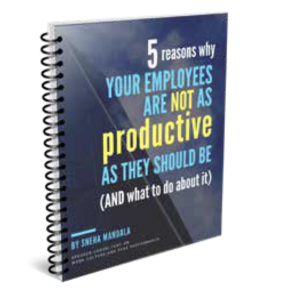In the ever-evolving work landscape, especially in the wake of the global shift to remote and hybrid models, the quest for optimal employee performance has become a central concern for leaders. As a champion of sustainable peak performance and a certified professional executive coach, I frequently encounter leaders grappling with the complexities of remote work productivity. It is high time we shift our focus from mere outcomes to optimizing the inputs for the best results.
The common knee-jerk reaction to a remote employee’s poor performance is often the assumption of slacking because of a lack of micro-supervision. However, the reality is far more nuanced. Many issues could be at play—mismatched job responsibilities, a lack of autonomy, the need for support, or the struggle to stay authentic within job constraints. This realization brings us to a crucial point—evaluating productivity should go beyond surface-level assessments and consider the deeper factors influencing an employee’s engagement and well-being.
Integrating remote and in-office dynamics, the hybrid work model brings an additional layer of intricacy. By adopting “return-to-hybrid” policies, leaders seek software to monitor employee presence—whether in the office or remotely. Some of these tools use Artificial Intelligence (AI) as well. However, employees resist the widespread use of such productivity-tracking tools. Many employees commonly express discomfort, feeling like they are under the watchful eye of “Big Brother.” This raises a significant challenge: How can leaders effectively measure employee engagement without using tools that trigger a sense of being surveilled?
To address this challenge, leaders must recognize the importance of balancing the need for tracking employees’ concerns about privacy and their autonomy. Leaders need to foster an environment of trust where results are emphasized over constant monitoring. Open communication channels can play a pivotal role in understanding what methods work best for leaders and employees, ensuring that the quest for engagement does not compromise the sense of autonomy and comfort among the workforce.
We do not have to reject technology entirely. For example, AI’s capabilities extend far beyond mere efficiency monitoring. It is a strategic ally, introducing objectivity and scalability to core HR functions. Leaders, leveraging AI insights, gain a nuanced understanding of employee needs, allowing them to cultivate a positive work culture that fosters engagement and satisfaction. Moreover, AI proves instrumental in addressing intricate challenges such as turnover and burnout and optimizing overall performance management.
Within the broader context of reshaping work environments, AI technologies like Flow-Pilot1, powered by Dataken’s OLi, assume a pivotal role. These tools enable data-driven decision-making, streamline processes, and enhance organizational agility. Integrating AI is not just about efficiency; it catalyzes innovation and adaptation in constant workplace evolution.
Before delving into the specifics of AI tools, let us lay a comprehensive foundation with practical strategies.
Navigating the Hybrid Work Landscape: Six Tips for Employees and Leaders
- Fostering Proactive and Transparent Communication:In navigating the hybrid work landscape, fostering proactive communication emerges as a cornerstone for employees and leaders. Regular check-ins facilitate discussions on work progress and play a pivotal role in building a sense of unity among team members. Inspired by the effective practices of remote team members after COVID-19, the adoption of a weekly email update system has become a valuable tool, actively encouraging open communication channels.
Employees should actively engage in these practices, recognizing their contribution to cultivating a communicative environment essential for effectively navigating the nuances of the hybrid workspace. For leaders, championing transparent communication practices is not just about keeping the team informed; it is a strategic approach that nurtures a keen sense of connection. Virtual town halls serve as dynamic platforms to convey company updates, ensuring every team member feels a part of the organizational narrative. Encouraging an open-door policy further fortifies a culture where employees freely share concerns and suggestions.
This commitment to transparent communication is foundational, creating an inclusive atmosphere that fosters trust and collaboration, proving instrumental in overcoming the unique challenges a hybrid work setting presents. Also, empathy is crucial in bridging the gap for remote and hybrid team members. Actively involve:
-
- Remote employees in team-building activities.
- Leveraging video calls.
- Instant messaging.
- Emails for regular communication.
Leaders can set the tone by participating in informal virtual gatherings and acknowledging individual contributions. Implement an open-door policy, encouraging employees to share their thoughts and concerns. Practical tips for employees include initiating virtual coffee breaks and sharing personal updates to foster a sense of connection. Leaders should prioritize regular virtual check-ins focused on work progress and understanding the unique challenges remote team members face.
- Championing Continuous Learning: Proactively seek diverse skill development opportunities and remain attuned to industry trends to maintain an agile and adaptive approach. Attend virtual workshops, especially those centered on project management, and actively apply the newly acquired skills to elevate the efficiency of team workflows. Additionally, set personalized learning goals and actively track progress through shared platforms, fostering a dynamic culture of growth and development within the team.
This initiative-taking commitment to continuous learning becomes a personal initiative and a strategic imperative for employees. It ensures individual adaptability and sustained personal development within the ever-evolving work environment. Actively engaging in skill enhancement contributes to personal effectiveness in the hybrid workspace and catalyzes the entire team’s collective growth. As critical influencers, leaders play a decisive role in actively championing a culture of continuous learning, empowering their teams to proactively evolve and thrive amidst the fluid dynamics of the contemporary work landscape.
- Dedication to Career Growth: Employees should prioritize a clear commitment to career growth in remote and hybrid work scenarios. Take ownership of your career path by proactively planning and pursuing your goals, even in a distance-based setting. Initiate discussions with your manager to collaboratively craft a career progression plan aligned with company objectives. Collaborate with mentors to formulate a personalized career development plan, leveraging their insights for strategic growth. Actively steering your career journey ensures alignment with personal aspirations and meaningful contributions to the company’s objectives within the hybrid work landscape.
For leaders, providing employees with transparent career progression frameworks fosters motivation and clarity in remote or hybrid settings. Consider implementing visual roadmaps for career progression, ensuring transparency and motivation among team members. Conduct regular career development check-ins with team members to facilitate ongoing growth discussions and align individual aspirations with organizational objectives. Flexible goal setting is vital to unlocking individual potential. Understand employees’ strengths and aspirations, aligning tasks to enhance motivation. Leaders should facilitate collaborative goal-setting discussions, ensuring alignment with individual and team objectives. Regularly revisit goals to accommodate changing priorities and encourage employees to lead in shaping their professional development. This positive commitment to career growth not only enhances individual professional journeys but also contributes to the overall success and resilience of the team in the dynamic landscape of hybrid work.
- Prioritizing Well-Being: A focus on well-being is a foundational pillar for individual resilience and collective success within the hybrid work paradigm. By proactively setting clear boundaries to maintain a healthy work-life balance, employees create a framework that not only safeguards their mental and physical health but also fosters sustained energy levels and heightened adaptability in the face of the unique challenges inherent to the hybrid work setup.
Moreover, active engagement in activities that promote overall well-being becomes a strategic choice, acknowledging the symbiotic relationship between individual vitality and professional effectiveness. For instance, scheduling short breaks for mindfulness is not merely a routine but a deliberate investment in mental well-being, contributing to increased focus and productivity. Furthermore, sharing well-being practices with the team goes beyond individual benefits; it fosters a collaborative and supportive culture where every team member is empowered to thrive. In essence, the rationale behind prioritizing well-being is rooted in its transformative impact on individual and collective resilience, fortifying employees to navigate the complexities of the hybrid work landscape with vigor and sustained effectiveness.
- Cultivating Autonomy, Trust, and Ownership:In navigating the complexities of a hybrid work environment, fostering autonomy, trust, and ownership is pivotal for sustained success. Employees can cultivate autonomy by proactively managing their time and tasks. Establish clear goals, create a structured daily plan, and communicate transparently about progress. For leaders, instilling trust involves guiding while allowing room for individual decision-making. Regular check-ins should focus on support rather than micromanagement.
Ownership is nurtured through a shared understanding of the organization’s mission. Leaders should articulate the company’s vision, emphasizing each team member’s role in achieving it. Encourage open dialogue and feedback, making it clear that contributions are valued. Employees, in turn, can take ownership by aligning their work with broader objectives, showcasing initiative, and learning from challenges. Striking this balance fosters a culture of autonomy, trust, and ownership, fortifying teams in the dynamic landscape of hybrid work.
- Leveraging Technology for Enhanced Flexibility: Employees benefit from embracing a mindset that prioritizes adaptability, allowing them to navigate evolving tasks and responsibilities seamlessly. Leveraging technology, employees can use project management tools, collaborative platforms, and automation solutions to enhance their agility. For instance, adopting cloud-based collaboration tools facilitates real-time communication and efficient project execution, enabling employees to respond swiftly to changing work dynamics.
Leaders, on the other hand, play a crucial role in fostering organizational agility. They can implement agile methodologies and utilize advanced analytics to expect trends, enabling active decision-making. Technology tools like data analytics platforms and project management systems empower leaders to streamline workflows, allocate resources efficiently, and respond swiftly to market shifts. For employees and leaders, embracing agility and leveraging technology go together, ensuring a responsive and dynamic approach to the challenges of the modern hybrid work environment.
 The Role of ‘Flow-Pilot’ in Enhancing Productivity
The Role of ‘Flow-Pilot’ in Enhancing Productivity
Now, let us turn our attention back to the role of AI, specifically Flow-Pilot,1 in enhancing productivity and fostering a state of flow for employees. Flow-Pilot is a technological marvel, leveraging advanced machine learning algorithms like Decision Tree and K-nearest neighbors. These algorithms, backed by extensive data analysis, ensure precise and personalized insights into employee preferences and work patterns.
Integrating large language models in the backend allows Flow-Pilot to understand and interpret complex language nuances. This linguistic proficiency contributes to more accurate and context-aware suggestions, making the tool highly effective in real-world work scenarios.
While the back end operates with innovative technology, the front end of Flow-Pilot boasts a user-friendly interface. This ensures employees can easily navigate and derive value from the tool regardless of their technical proficiency. Seamless integration into everyday work processes is crucial, enhancing existing workflows rather than disrupting them.
One of the standout features of Flow-Pilot is its ability to provide personalized suggestions for task optimization. These suggestions go beyond generic insights, offering actionable recommendations that align tasks with individual strengths. The result is a workplace where employees feel more connected to their roles, making work less routine and a source of fulfillment.
The success story of Flow-Pilot becomes clear when we examine its real-world impact. In one such case for the customer service division of a Fortune 50 company, the six-month implementation of Flow-Pilot resulted in a remarkable 31% spike in employee engagement. The Net Promoter Score, a measure of how highly customers are likely to recommend the company, saw an impressive 40-point surge during this period. Customers noticed the change, attributing it to the exceptional quality of service they received.
Flow-Pilot redefines tools for a hybrid work environment —crafted for employee well-being, not surveillance. In contrast, the typical “big brother” tool monitors but misses the user-centric finesse. Opt for functionality that enriches, not just oversees. Choose tools that empower, not just scrutinize.
Conclusion
As we navigate the dynamic terrain of remote and hybrid work, the pursuit of optimal employee performance takes center stage. Our focus has shifted from outcome-centric approaches to the intricate factors shaping engagement and well-being. In the face of hybrid work complexities, balancing the need for tracking with privacy and autonomy is paramount, underlining the significance of open communication.
Artificial Intelligence, exemplified by tools like Flow-Pilot, emerges not as a disruptor but as a transformative force. Its integration, combined with foundational strategies like transparent communication, continuous learning, career growth dedication, well-being prioritization, and technology leverage, reshapes the modern workplace. With its advanced algorithms, Flow-Pilot offers personalized insights, enhancing productivity and work satisfaction.
In practical situations, the success of initiatives driven by AI emphasizes the tangible impact of embracing strategies that combine both human and AI elements, unlocking the authentic potential of employees. As organizations champion this integrated paradigm, they not only adapt to the challenges posed by the hybrid work era but also pave the way for sustained success in the continually evolving work landscape.
Endnotes
1 The Flow-Pilot – Your Friendly AI Co-Pilot (2023, December 20). https://snehamandala.com/introducing-flow-pilot/
2 Sneha Mandala – Speaker on Work Culture & Peak Performance. (2022, December 4) | Join the “Effortless Work” Revolution! https://snehamandala.com/

